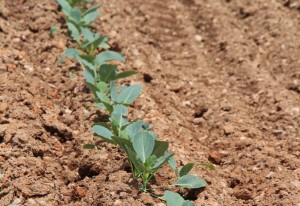Not every crop needs the bright sun and blistering heat of summer to flourish. In fact, some of our most familiar vegetables are considered cool weather crops, meaning they may do even better in the early spring and fall than in the middle of summer when all the other crops are growing like crazy. Some examples of cool weather crops include broccoli, cabbage, and other brassicas (relatives of the wild mustard plant: kale, Brussels sprouts, cauliflower, and more). Other crops include lettuces, carrots, peas, onions, and the list goes on!
Why Cool Weather Crops?

Growing crops in cool weather, whether on the farm or in the backyard garden, can have some distinct advantages, the biggest of which is a reduction in insect pressure. This means, fewer bugs are around to gobble up the vegetables. It is a lot harder for cabbage moths to lay their eggs with an autumn breeze nipping their wingtips. In addition, these cold- and frost-hardy plants mean farmers can extend their growing seasons into times of the year when they wouldn’t normally be able to farm. Some crops even taste better with a little touch of cool weather, due to plants producing sugars to protect themselves from freezing.
What does this mean for farmers?
Planning for cool weather crops can be a critical part of a farmer’s year. A few years back, I got the chance to visit a friend in Virginia with plans for getting broccoli and cabbage ready to grow for places like Whole Foods and Ingles’ Markets. He lets his seedlings grow in a hydroponic system so the seedling trays are kept in water.

This method ensures his seedlings are healthy and strong when it comes time to plant them out. When the weather is chilly, they grow under tunnel greenhouses, and when things warm up, they open their greenhouses up to let the seedlings bask in the fresh air. In the below picture, you can see how similar the seedlings look! The main way to tell the broccoli apart from the cabbage is the slight color difference.
On the Podcast
We’ve talked to several farmers who grow crops that do well in cool weather.
Lettuce, especially head lettuce (like iceberg) is a great crop to grow when the weather is cooler. Way back in 2019, we talked to lettuce farmer, Jon Dinsmore. You can also check out a tour of his lettuce farm in Arizona.
Onions are another crop that can be grown in the cooler months. In fact, for onions to produce seeds, they need to overwinter! Check out our talk with Shay Myers of Owyhee Produce and see a video of the unique way onions are harvested.
And if you want to know more about gardening, urban farming, and how you can get started with your own cool weather crops (and warm weather crops, for that matter), you should really take a look at the We Sow, We Grow program, led by Natasha Nichols up in Chicago. She’s doing incredible work and helping gardeners of all levels and backgrounds grow food.




